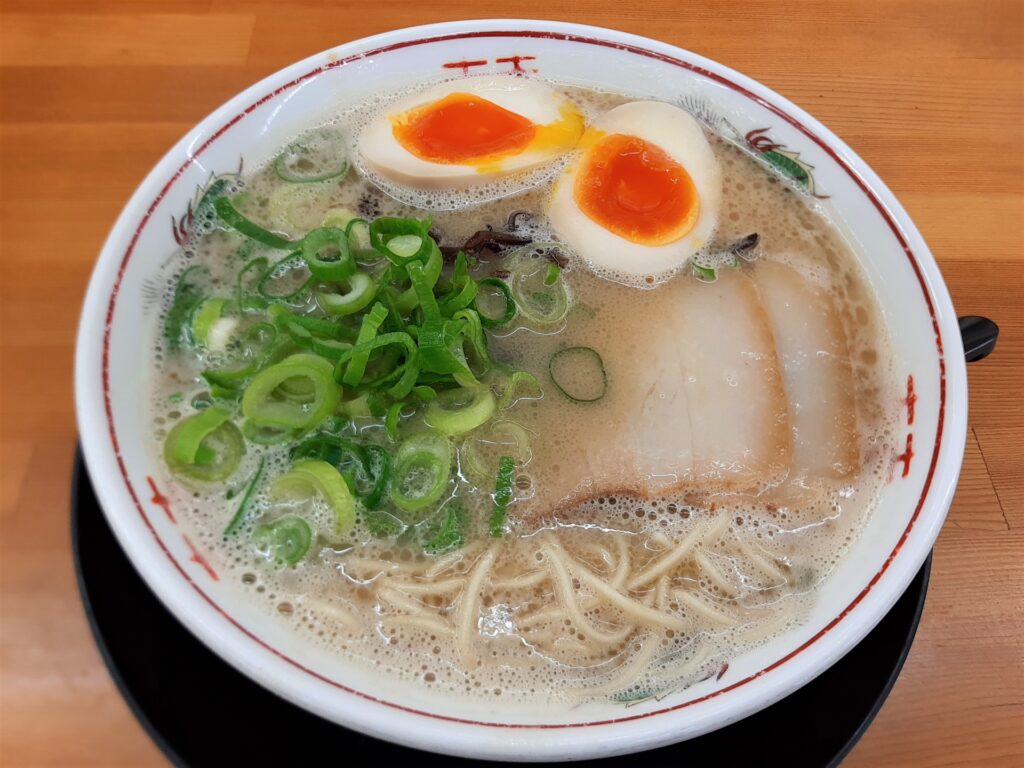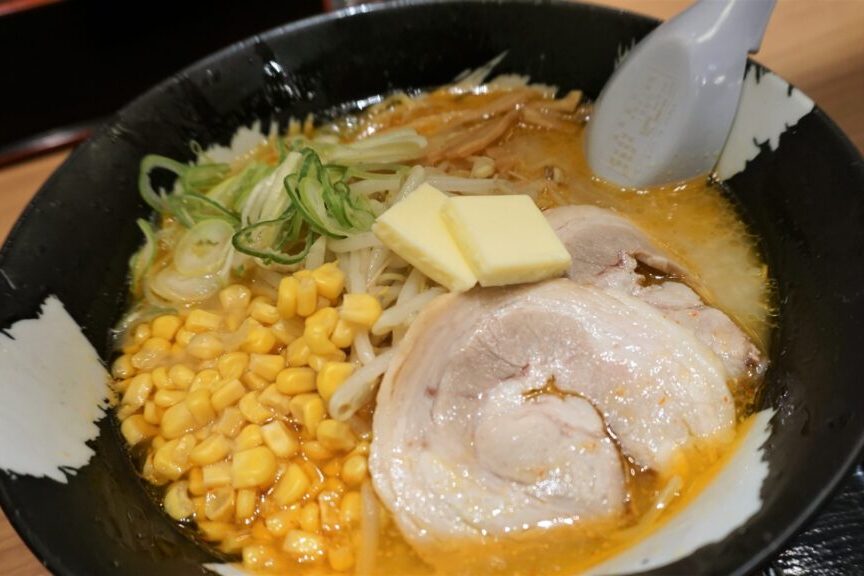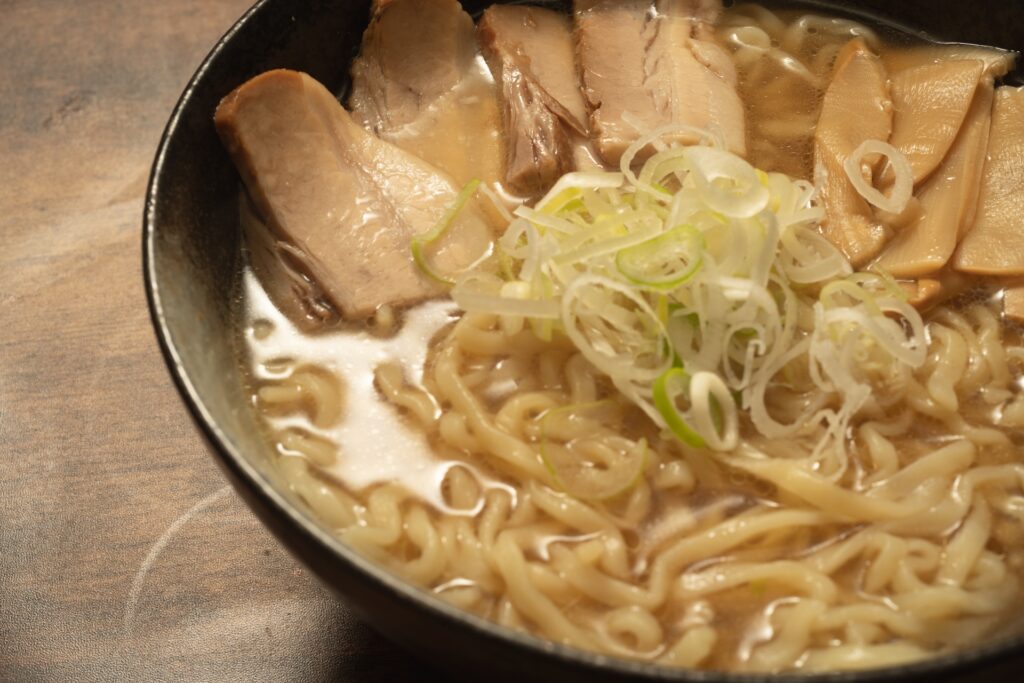
Contents
Hakata Ramen
Hakata Ramen is a tonkotsu (pork bone) ramen mainly served in Fukuoka City, Fukuoka Prefecture, and is offered in ramen specialty shops, Chinese restaurants, and food stalls. Originally, it was simply called “ramen”, but in 1977, Rumi Tomura, the second-generation proprietress of “Hakata Ramen Shibaraku” in Nishijin, Sawara Ward, Fukuoka City, devised the name “Hakata Ramen”. Since then, tonkotsu ramen shops in Fukuoka City started to identify themselves as “Hakata Ramen”, and this name has spread across the whole country.
概要
Hakata Ramen, while its flavor and appearance vary from shop to shop, is characterized by its milky white soup primarily made from pork bones and thin straight noodles similar to Shimabara somen. Another distinctive feature is the ability for customers to choose the hardness of the noodles and the option for additional servings of noodles, known as “kaedama”. The popularity of local ramen has led to an increase and establishment of ramen shops in and around Fukuoka City. While named “Hakata Ramen”, it is served not only in the Hakata district and the areas surrounding Hakata Station, but also widely across Fukuoka City, including Tenjin and Nagahama. The nationwide expansion and the sale of instant cup versions have increased the popularity of Hakata Ramen across Japan. In addition, in Fukuoka City, new variations have been created by fusing with other regional ramens at places like the Ramen Stadium in Canal City Hakata. Some shops offer 24-hour service and are often chosen as the final stop after parties. Hakata Ramen is also served at food stalls in the bustling downtown areas of Fukuoka City, and is available in a stand-and-eat style at JR Kyushu’s Hakata and Kokura Stations.
発祥
There are several theories regarding the origin of Hakata Ramen. The most widely accepted one is that in 1937, a man from Nagasaki named Miyamoto Tokio first served Tonkotsu Ramen in his restaurant, Nankin Senryo, in Kurume. This is considered the root of Kurume Ramen, and subsequently Hakata Ramen. Between 1941 and 1942, a stall named “Sambashi” was opened by Mori Kentaro, where he served Ramen with a clear pork bone soup and flat noodles. In 1946, Inoue Seizaemon, who had learned Chinese cuisine, started serving clear pork bone Ramen in his stall named “Hakata-sou.” That same year, Tsuda Shigeru opened a stall named “Akanoi” and began serving Ramen inspired by the milky pork bone soup he had tasted in China. Additionally, a theory exists that in 1946, Tsuda Shigeru and Yamahira Susumu jointly created what is now known as Hakata Ramen. Furthermore, in 1947, a stall named “Sanku” in Kurume city accidentally invented a milky pork bone soup. This soup became the origin of Kurume Ramen, which eventually spread and evolved into Hakata Ramen.
Nagahama Ramen(長浜ラーメン)
Nagahama Ramen refers to the ramen served mainly in shops and food stalls in Nagahama, Chuo Ward, Fukuoka City. In 1955, when the Fukuoka City Central Wholesale Market Fish Market moved to Nagahama, several market ramen stalls also relocated there. The features of Nagahama Ramen, which was mainly for market-related workers, include extra-thin noodles that can be boiled quickly, additional orders of just noodles (known as “kaedama”), and a surprisingly light soup made mainly from pork bones. These features were developed for workers to be able to eat quickly during breaks in their work at the market. In addition, ramen sauce (for when the soup becomes diluted from added noodles), red pickled ginger, and sesame seeds are prepared at each table, allowing customers to adjust the flavor and aroma to their liking.
noodles(麺)
The noodles used in Hakata ramen are often very thin and straight, made with a specific wheat developed by Fukuoka Prefecture called “Rāmugi.” Due to a low water content, these noodles lack firmness, which gives them the characteristic of easily absorbing soup. The thinness of the noodles allows for a better blend with the soup, and enables quick cooking and serving, catering to busy market workers during late night and early morning hours. Another distinctive feature of Hakata ramen is that customers can choose the hardness of their noodles. Expressions like “barikata” (very hard), “kata” (hard), “futsuu” (normal), “yawa” (soft), and “bariyawa” (very soft) are commonly used. People in Fukuoka are known for their impatient temperament, resulting in many people preferring their noodles on the harder side. However, not all restaurants use the emphasis expression “bari,” and customers often specify their desired hardness as “nama” (very hard), “kata,” or “yawa.” If a customer from outside the prefecture, including tourists, orders “barikata,” they may be corrected to say “nama” by the restaurant staff.
具材
The toppings of Hakata Ramen are simple, with some establishments serving it with just green onions, or green onions and chashu (roasted pork fillet). Other commonly seen ingredients include wood ear mushrooms, bean sprouts, bamboo shoots, and seaweed, although these can vary by restaurant. In the past, wood ear mushrooms were used as a substitute due to the fluctuating prices of seaweed, and this practice has continued to the present day. Additionally, during the early days of tonkotsu (pork bone) ramen, there was an unsanitary image associated with pork, leading to the use of pickled red ginger as a topping to counteract this.Condiments such as white sesame, pickled red ginger, and spicy mustard leaf are placed on the tables, allowing customers to top their ramen according to their preferences. While these condiments help to remove the distinctiveness of the tonkotsu soup, they also weaken the flavor of the pork bone itself, leading some ramen shops to refrain from offering such toppings. The practice of topping the ramen with white sesame or ground sesame originated in the 1940s, when the aroma of the tonkotsu soup was particularly distinctive. Modern tonkotsu ramen has become milder due to changes in the pig feed, which now consists of mixed feeds. The idea of adding white sesame (ground sesame) was conceived by Yasunori Tonomura, the founder of “Hakata Ramen Shibaraku” located in Nishijin, Sawara Ward, Fukuoka City.
スープ
Hakata ramen is known for its characteristic pork bone soup, the viscosity of which is due to collagen. However, the image of “Hakata Ramen” = “rich and heavy” is only a part of the truth. In particular, many local shops, long-established shops, and food stalls offer a lighter soup. But in recent years, as the reputation of “Hakata Ramen” has spread nationwide, there has been an increase in new shops, and shops that serve a richer ramen have also increased. However, these are recognized as different from the traditional, lighter Hakata ramen. The unique aroma of pork bone ramen is a matter of personal preference. Some shops try to suppress the smell by carefully bleeding the pork bones, adding spices such as ginger, or making a mixed soup with chicken bones. These ramen with suppressed pork bone smell are sometimes referred to as “Light Tonkotsu”.
替え玉
Many restaurants have adopted the “kaedama” system, which allows customers to add extra noodles to their dish. Typically, the firmness of the kaedama can be specified. A unique feature is ordering firm noodles and promptly ordering another firm kaedama, allowing the meal to be satisfying for a longer time. This system is now widespread across the country.
お店
・Hakata Ramen Shibaraku – Established in 1953 in Nishi-Shin, Sawara Ward, Fukuoka City. Coined the term “Hakata Ramen” in 1977, which has since spread nationwide. The originator of sesame and wood ear mushroom toppings.
・Red Lantern Mackerel Chan Ramen – A long-established restaurant with over 50 years of history, located in Akasaka (West Street), Chuo Ward, Fukuoka City.
・Dharma Ramen – Located in Naka, Hakata Ward, Fukuoka City.
・Number One – Located in Gion, Hakata Ward, Fukuoka City.
・Ganso Nagahama-ya – Located in Nagahama, Chuo Ward, Fukuoka City. The originator of the kaedama (extra noodle) system.
・Nagahama Yatai Isshinte – Located in Nagahama, Chuo Ward, Fukuoka City. Has several branches.
・Hakata Manor – Opened in Nakasu, Hakata Ward, Fukuoka City, with the help of Chinese personnel.
・Hakata Ippudo – Based in Daimyo, Chuo Ward, Fukuoka City, with chain stores both domestically and internationally.
・Ichiran – Based in Fukuoka City, with chain stores both domestically and internationally.
・Hakata Tenjin – A chain store operating in Tokyo.
・Kyushu Ichiban – Has a factory in Kyushu and chain stores in Kanto.
・Marukin Ramen – Operates chain stores in the Tokyo metropolitan area and abroad.
・Hakata Furyu – Operates chain stores in Tokyo.
・Yumaru – Operates chain stores in Tokyo, Saitama City, and abroad.
・Jin Corporation – Operates chain stores in eastern Japan.
・Hakata Ramen Genkotsu – Operates chain stores in Osaka and Hyogo prefectures.
・Hakata Ikko-sha – Based in Fukuoka Prefecture, with chain stores both domestically and internationally.
・Hakata Sanki – Operates chain stores mainly in the suburbs of Fukuoka City.
・Nagahama Number One – Originating from Nagahama yatai (food stalls).
・Hakata Nagahama Ramen Tanaka Shōten.




